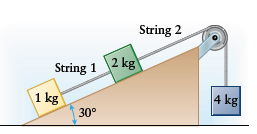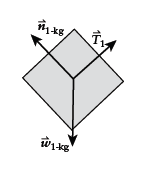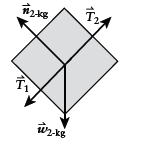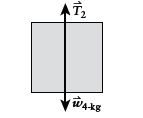
Concept explainers
The acceleration of the masses and tension in the strings.
Answer to Problem 101QAP
Tension in String
Tension in String
acceleration of the masses
Explanation of Solution
Givendata:
Mass of block A,
Mass of block B,
Mass of block B,
Formula Used:
Newton's second law:
Calculation:
For theblocks on the ramp, we can use a coordinate system wherethe axes are parallel and perpendicular to the face of theramp and up the ramp is considered positive.
For the
All three blocks have the sameacceleration because they are joined together.
Using Newton's second law for each of theblocks, we can solve for the acceleration in terms of the known masses.
Once we calculate theacceleration, we can calculate the magnitudes of the tensions.

Free-body diagram of

Free-body diagram of

Free-body diagram of

Newton's second law:
Solving for the acceleration:
Solving for the tensions:
Conclusion:
Thus, we havethe acceleration of the masses and tension in the strings as below: -
Tension in String
Tension in String
acceleration of the masses
Want to see more full solutions like this?
Chapter 4 Solutions
FlipIt for College Physics (Algebra Version - Six Months Access)
- In a national park, the current population of an endangered species of bear is 80. Each year, the population decreases by 10%. How can you model the population of bears in the park? # of years # of bears 9 10 2 3 4 5 6 7 8 ° 1 Graph your data. Remember to title your graph. What scale should be used on the y-axis? What scale should be used on the x-axis? SMOKY 19 OUNTAINS NATIONAL Exponential Decay Equation y = a(1-r)* PARKarrow_forwardOn Feb. 8, this year, at 6am in the morning all UiB meteorology professors met to discuss a highly unfortunate and top-urgent crisis: Their most precious instrument, responsible for measuring the air temperature hour-by- hour, had failed - what if the Bergen public would find out? How would they plan their weekend without up-to-date air temperature readings? Silent devastation - and maybe a hint of panic, also - hung in the room. Apprentice Taylor, who - as always - was late to the meeting, sensed that this was his chance to shine! Could they fake the data? At least for some hours (until the measurements would work again)? He used to spend a lot of time online and thus knew the value of fake data, especially when it spread fast! He reminded the crying professors of a prehistoric project with the title "Love your derivatives as you love yourself!" - back then, they had installed top-modern technology that not only measured the air temperature itself, but also its 1st, 2nd, 3rd, 4th, and…arrow_forwardConsider a forest where the population of a particular plant species grows exponentially. In a real-world scenario, we often deal with systems where the analytical function describing the phenomenon is not available. In such cases, numerical methods come in handy. For the sake of this task, however, you are provided with an analytical function so that you can compare the results of the numerical methods to some ground truth. The population P(t) of the plants at time t (in years) is given by the equation: P(t) = 200 0.03 t You are tasked with estimating the rate of change of the plant population at t = 5 years using numerical differentiation methods. First, compute the value of P'(t) at t = 5 analytically. Then, estimate P'(t) at t = 5 years using the following numerical differentiation methods: ⚫ forward difference method (2nd-order accurate) 3 ⚫ backward difference method (2nd-order accurate) ⚫ central difference method (2nd-order accurate) Use h = 0.5 as the step size and round all…arrow_forward
- Nicole organized a new corporation. The corporation began business on April 1 of year 1. She made the following expenditures associated with getting the corporation started: Expense Date Amount Attorney fees for articles of incorporation February 10 $ 40,500 March 1-March 30 wages March 30 6,550 March 1-March 30 rent Stock issuance costs March 30 2,850 April 1-May 30 wages Note: Leave no answer blank. Enter zero if applicable. April 1 May 30 24,000 16,375 c. What amount can the corporation deduct as amortization expense for the organizational expenditures and for the start-up costs for year 1 [not including the amount determined in part (b)]? Note: Round intermediate calculations to 2 decimal places and final answer to the nearest whole dollar amount. Start-up costs amortized Organizational expenditures amortizedarrow_forwardLast Chance Mine (LCM) purchased a coal deposit for $2,918,300. It estimated it would extract 18,950 tons of coal from the deposit. LCM mined the coal and sold it, reporting gross receipts of $1.24 million, $13 million, and $11 million for years 1 through 3, respectively. During years 1-3, LCM reported net income (loss) from the coal deposit activity in the amount of ($11,400), $550,000, and $502,500, respectively. In years 1-3, LCM extracted 19,950 tons of coal as follows: (1) Tons of Coal 18,950 Depletion (2) Basis (2)(1) Rate $2,918,300 $154.00 Tons Extracted per Year Year 1 4,500 Year 2 8,850 Year 3 6,600 Note: Leave no answer blank. Enter zero if applicable. Enter your answers in dollars and not in millions of dollars. a. What is LCM's cost depletion for years 1, 2, and 3? Cost Depletion Year 1 Year 2 Year 3arrow_forwardConsider the following equation. log1/9' =6 Find the value of x. Round your answer to the nearest thousandth. x = ✓arrow_forward
- Expanding a logarithmic expression: Problem type 3 Use the properties of logarithms to expand the following expression. 4(8+x)² log 5 ) Your answer should not have radicals or exponents. You may assume that all variables are positive. log 4(8 + X 5 -x)²arrow_forwardUse the properties of logarithms to expand the following expression. log 6(x+5)² 3/24 Your answer should not have radicals or exponents. You may assume that all variables are positive. log 6(x + 3 I 4 5)² log Xarrow_forwardExpanding a logarithmic expression: Problem type 2 Use the properties of logarithms to expand the following expression. 3 yz log 5 x 0/3 An Each logarithm should involve only one variable and should not have any radicals or exponents. You may assume that all variables are positive. log yz 3 厚 5 Explanation Check log ☑ 2025 MG ¿W MIII LLC. All Rights Reserved. Terms of Use | Privacy Centerarrow_forward
- Expanding a logarithmic expression: Problem type 2 Use the properties of logarithms to expand the following expression. 3 yz log 5 x 0/3 An Each logarithm should involve only one variable and should not have any radicals or exponents. You may assume that all variables are positive. log yz 3 厚 5 Explanation Check log ☑ 2025 MG ¿W MIII LLC. All Rights Reserved. Terms of Use | Privacy Centerarrow_forwardWhat is the domain and range, thank you !!arrow_forwardAssume a bivariate patch p(u, v) over the unit square [0, 1]² that is given as a tensor product patch where u-sections (u fixed to some constant û; v varying across [0, 1]) are quadratic polynomials Pu:û(v) = p(û, v) while v-sections are lines pv:ô (u) = p(u, v). The boundary lines pv:o(u) and pv:1 (u) are specified by their end points p(0,0) 0.8 and p(1,0) 0.2 as well as p(0, 1) 0.3 and p(1, 1) = 0.8. The boundary quadratics pu:o(v) and pu:1 (v) interpolate p(0,0.5) = 0.1 and p(1, 0.5) = 0.9 in addition to the above given four corner-values. = = = Use Pu:û(v) = (1, v, v² ) Mq (Pu:û(0), Pu:û (0.5), Pu:û(1)) with Ma = 1 0 0 -3 4-1 2 4 2 (Pv:ô as well as pu: (u) = (1, u) M₁ (pv:v (0), P: (1)) with M₁ = = (19) 0 to formulate p(u, v) using the "geometric input" G with G = = (P(0,0%) p(0,0) p(0,0.5) p(0,1) ) = ( 0.39 0.8 0.1 0.3 0.2 0.9 0.8 p(1,0) p(1, 0.5) p(1, 1) See the figure below for (left) a selection of iso-lines of p(u, v) and (right) a 3D rendering of p(u, v) as a height surface…arrow_forward
 Trigonometry (MindTap Course List)TrigonometryISBN:9781305652224Author:Charles P. McKeague, Mark D. TurnerPublisher:Cengage LearningAlgebra & Trigonometry with Analytic GeometryAlgebraISBN:9781133382119Author:SwokowskiPublisher:Cengage
Trigonometry (MindTap Course List)TrigonometryISBN:9781305652224Author:Charles P. McKeague, Mark D. TurnerPublisher:Cengage LearningAlgebra & Trigonometry with Analytic GeometryAlgebraISBN:9781133382119Author:SwokowskiPublisher:Cengage Elementary Geometry For College Students, 7eGeometryISBN:9781337614085Author:Alexander, Daniel C.; Koeberlein, Geralyn M.Publisher:Cengage,
Elementary Geometry For College Students, 7eGeometryISBN:9781337614085Author:Alexander, Daniel C.; Koeberlein, Geralyn M.Publisher:Cengage,


